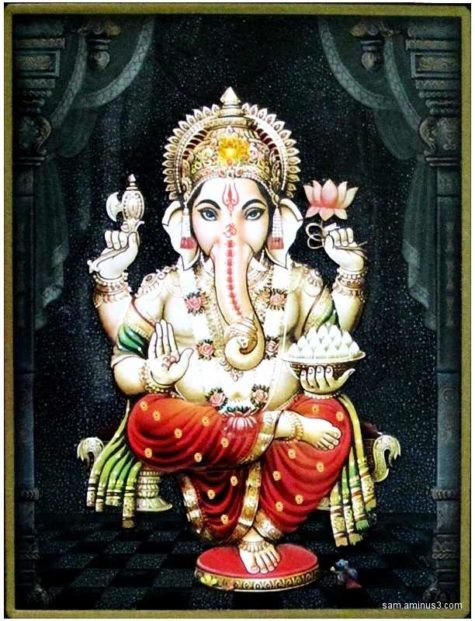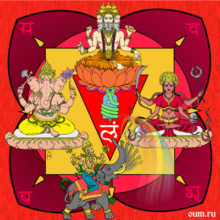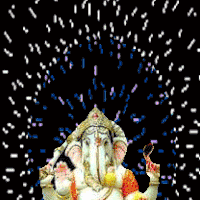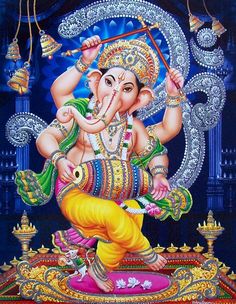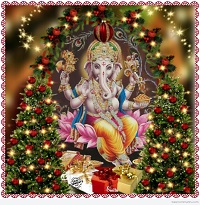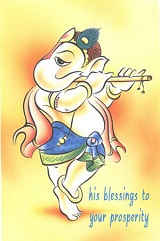Chakra
Ganesha Lord of the Root Chakra
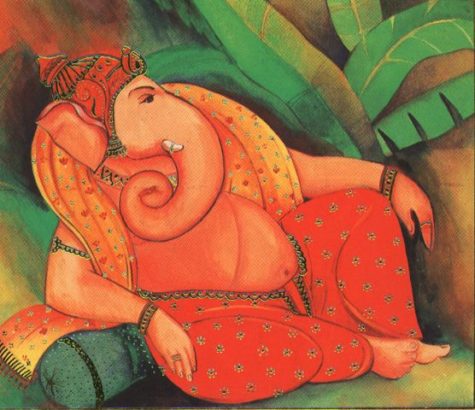
As per Kundalini Yoga Sutra, the human body receives its subtle cosmic energies from seven chakras that are ruled by different gods. The Muladhara is considered the “root” or “foundation” Chakra indicating “support” is one of the seven main chakras, located near the base end of the spinal column, primarily associated with the action of excretion. Muladhara Chakra is associated with survival and safety and teaches us the life lesson of standing up for ourselves.
An individual with a healthy Muladhara Chakra can be spotted out for a strong sense of security and practicality with a healthy physique. On the other hand, if this first Chakra is blocked, a person may lose the sense of belonging, have a weak physical structure, problematic bones, weight issues, and a fearful outlook towards life in general.
Lord Ganesha rules Muladhara Chakra, the root Chakra sssociated with family, stability and wealth. Mula means “main, root or original” and adhara means “base”, meaning that Lord Ganesha is the root cause of our familial happiness and domestic peace that are absent without his blessings.
Also in Ganapati Atharvashirsa it is given that “lord Ganesha continually dwells in the sacral plexus at the base of the spine, Muladhara Chakra. He resides permanently in every living being at the Muladhara. He guides all other chakras, thereby leading the forces that propel the wheel of life.”
Therefore, Lord Ganesha is the primal force that supports the foundation of every aspect of your life. He removes all the obstacles in all your undertakings. One should meditate on him every day in the morning. One can also use Ganesha Yantras or Rudraksha beads ruled by Lord Ganesha to strengthen your Root Chakra.
Source: The Rudra Centre
The Significance of Ganesha
The Divine Mother assumes infinite names and forms, each of which expresses a different facet of Her being. The deity Ganesha, Her first-born son, is a case in point. Ganesh is a compound of the Sanskrit words gana and isha. Gana means “individual beings, independent units, segments of light, discrete bodies of Divinity, unique forces, emanations of Divine Light, attendants of the main deity.” Isha. means “one who is capable of doing what he wishes, capable of refraining from what he does not wish to do, and capable of undoing that which has already been done” – in short, the Almighty Lord.
Ganesha dwells eternally in the womb of the Divine Mother. He is the “firstborn one,” emerging from Her before any of the functioning forces of the universe emerge. In their manifest form all these forces center around this primordial force – Ganesha is the locus for all that exists. He establishes law and brings order out of chaos, causing the universal forces to function coherently.
The first step in bringing order out of chaos is the emergence of the law of gravity, and Ganesha is the presiding deity of that law. At his behest the force of gravity captures all the matter and energy emitted by the primordial Divine Force and gives direction to its outward movement. Ganesha himself is the center of all gravitational energy, and as such he supervises all activities, from the microcosm to the macrocosm-everything in the universe is held by the invisible strings of gravity, while gravity itself is held by Ganesha. The forces of creation, maintenance, and destruction are held in harmonious balance by his will, and that is why this firstborn child of the Divine Mother is called “Ganesha,” the lord of all entities and functioning forces of the universe.
According to the chakra scheme of kundalini yoga, Ganesha resides in the first chakra, the muladhara. Mula means “original, main”; adhara means “base, foundation.” From the standpoint of manifestation, or outward expansion of the primordial Divine Force, the muladhara chakra is the principle on which everything rests. In his visual form at the muladhara center, Ganesha is described as an enormous man with the head of an elephant. He is heavy and strong, capable of crushing obstacles into dust. Seated at the base of the spine he holds, supports, and guides all other chakras, thus governing the forces that propel the wheel of life.
To understand the symbolic meaning of Ganesha’s personality we have to examine his personified form. Half human and half elephant, he represents human intelligence wedded to the strength of an elephant. The parts of his body are disproportionate: he has big ears, small eyes, a long trunk,a massive belly, and small feet. He is paradox embodied: although he is enormous, his vehicle is a mouse; he consumes huge quantities of food, yet he is an ascetic; he is fat and his legs are short, yet he is master of the dance.
His boundless intelligence is symbolized by his big head.The epithet given to him in both Vedic and tantric scriptures is Brahmanaspati, “lord of knowledge and intelligence” or “lord of pervasiveness.” The scriptures also refer to him as Jyeshtha Raja, “the eldest son,” even though he was never born.
Ganesha’s massive belly symbolizes his capacity to consume and contain the universe that evolves from the Divine Mother. As the lord of gravitational energy he has the capacity to pull anything toward himself and process it as he wishes. He also sets the wheel of karma in motion. That is why the scriptures describe him as Karma Adhyaksha, “the one who presides over karmic law.”
Ganesha is immortal. In him lies the seed of omniscience,and the most subtle mysteries of the universe are known to him, including the mysteries related to our mind, karma, and the cycle of birth and death. The rays of light emanating from him enable us to comprehend our deeply rooted karmic impressions and discover how to attain freedom from the binding forces of our mind. Only then are the obstacles emerging from its unlit corners fully destroyed. Hence he is called Vighnesha, “the lord who removes obstacles.”
Like fire,Ganesha consumes anything in his path with his enormous appetite. He is pleased with any offering we make to him with love – he gladly accepts our problems and concerns and swallows them, granting us freedom once and for all. No force other than Ganesha is capable of consuming our ignorance, egoism, attachment, aversion, and fear of death.That is also why he is called Vighnesha, “the lord who removes obstacles.”
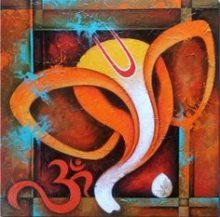 His big ears symbolize his limitless capacity for hearing.He hears our prayers regardless of how we recite them – he does not care whether or not we sing hymns in his praise, he considers our heartbeat and brainwaves to be forms of prayer.Any irregularity, whatever the cause, catches his attention.Being Ganesha, the head of the family, he rushes to our rescue.For these reasons, too, he is known as Vighnesha, “the lord who removes obstacles.”
His big ears symbolize his limitless capacity for hearing.He hears our prayers regardless of how we recite them – he does not care whether or not we sing hymns in his praise, he considers our heartbeat and brainwaves to be forms of prayer.Any irregularity, whatever the cause, catches his attention.Being Ganesha, the head of the family, he rushes to our rescue.For these reasons, too, he is known as Vighnesha, “the lord who removes obstacles.”
The fluid that sometimes flows from the temporal gland of male elephants flows constantly from Ganesha, and drawn by its sweet aroma insects drink the nectar. Intoxicated, they buzz around his ears, which he flaps gently in order to ward them off. This tells us metaphorically that Ganesha’s head, the treasure-house of wisdom, is so filled with the sweetness of love and compassion that it flows from him effortlessly and incessantly and is granted even to those who come to him with a noisy mind.
Set in his enormous head, Ganesha’s eyes are small because he has little use for them. However his third eye, the eye of intuition, is wide open, and he sees past, present, and future simultaneously. Seated as he is deep within every living and non-living entity, he sees everything. That is why he is called Adi Rishi, “the primordial seer.” He is the eternal source of knowledge – revelation flows through him. The scriptures refer to him as Parama Guru, “the master of all previous masters.”
The scriptures identify Ganesha with the sacred sound Om, and the shape of his trunk resembles the word written in Sanskrit. Because Om is the source of all mantras, repeating any mantra is tantamount to meditating on Ganesha.All sounds, words, and mantras in their dormant form rest in the muladhara chakra, where Ganesha resides.
The most subtle, vibrationless state of sound in the muladhara chakra is called “para.” At the behest of Ganesha,who presides over gravitational energy, a stirring arises in the muladhara chakra that can be detected only intuitively. This vibrationless vibration can be felt when it reaches the navel center; when it reaches the heart center, it assimilates the power of thinking; and it becomes audible when it reaches the throat center. Ganesha oversees this entire process. Without his assistance and guidance we can neither gain access to the muladhara center nor receive the ensuing revelation.That is why Ganesha is said to be the gatekeeper at the palace of the Divine Mother.
Though Ganesha’s feet are quite small, he outruns all the forces of the universe – because he pervades everything, he is already everywhere. Without moving, the lord of gravitational energy makes everything move. With his enormous body and tiny feet Ganesha dances to the song of the Divine Mother, and exhilarated by his movements, She joins in.Then, as mother and son perform their cosmic dance, all the arts and sciences spring forth. Unable to contain the divine ecstasy, the sages emerge from their absorption in Ganesha and assume their roles as our guides.
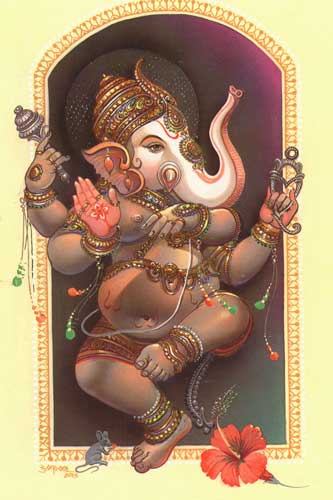 This cosmic dance symbolizes the process of kundalini awakening. The forces of darkness can cast their spell of slumber on us only as long as we are outside the pale of this dance. Thus Ganesha, the remover of obstacles, is the one who awakens the divine force in the form of kundalini shakti. He blesses us with shaktipata (the bestowing of divine energy). It is he who sends a sat guru (a true master) into our lives, and through his grace the forces of love, compassion, self-motivation, self-confidence, and determination unfold. Thus the scriptures assert that the door to the Divine Mother’s palace opens when Ganesha is pleased.
This cosmic dance symbolizes the process of kundalini awakening. The forces of darkness can cast their spell of slumber on us only as long as we are outside the pale of this dance. Thus Ganesha, the remover of obstacles, is the one who awakens the divine force in the form of kundalini shakti. He blesses us with shaktipata (the bestowing of divine energy). It is he who sends a sat guru (a true master) into our lives, and through his grace the forces of love, compassion, self-motivation, self-confidence, and determination unfold. Thus the scriptures assert that the door to the Divine Mother’s palace opens when Ganesha is pleased.
There are hundreds of ways to propitiate Ganesha and meditate on him. The tantric method, in conjunction with yantra sadhana, is precise and methodical. Those whose prolonged practice has gained them access to the muladhara center meditate on Ganesha by practicing the tantric method of kundalini yoga. To them, the human body is a yantra. Others draw the yantra of Ganesha on a gold, silver,or copper plate, on a silk cloth, on a wooden board, or on a piece of birch bark, and meditate on that.
From: Warrior of Light (India)
Awaken Shakti With The Ganesh Mantra
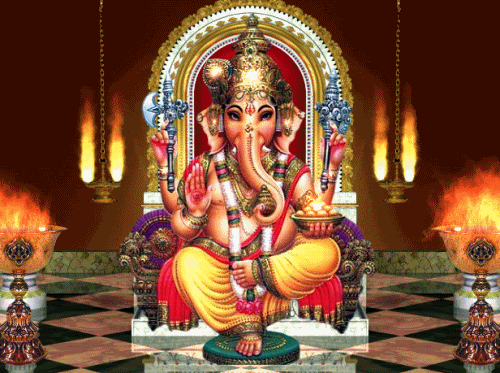
Here’s some info from Mind Body Green:
This is my favorite mantra to awaken Shakti, or the manifesting energy of the Universe, to stoke the fire of transformation within. I teach this mantra in classes, I sing it while driving in Los Angeles traffic and I have shared with with friends, family and students around the world because it’s easy and uplifting with the potential for great results.
According to the Buddhist Handbook, mantras are “highly compressed, power-packed formulas, usually of Sanskrit origin, which are charged with deep meaning and magical potency.” A mantra can be a word, sound or phrase which elevates or modifies consciousness through its meaning, sound, rhythm, tone and reflexology of the tongue against the palate of the mouth.
This particular mantra is “Om Gam Ganapataye Namaha,” which can be loosely translated to “Yo! Wake up Root Chakra energy of transformation so I can move through any obstacles in my life. Hooray!” Most importantly, we are calling upon the powerful energy of Ganesh, the elephant headed deity, who is widely revered as the Remover of Obstacles and the Lord of Beginnings.
According to Kundalini yoga, Ganesh, also referred to as Ganapataye, resides in the first chakra, called Muladhara (muladhara). Mula means “original,” and adhara means “foundation.” The muladhara chakra is the principal origin from which the manifesting energy of Shakti resides within each of us. When we awaken that energy, it helps us move through the Chakras with ease to activate a strong sense of self, express Divine love, communicate clearly and connect with our intuition.
This particular mantra is important because not only is it fun and catchy, but it also represents a willingness to release and move past the perceived obstacles in our lives. We can all make excuses for ourselves about why we cannot achieve our dreams, but you will have an easier time succeeding when you choose to focus on your goals rather than your challenges. So when you make the choice to chant this mantra, you are aligning yourself with your desired outcome and moving towards it with conviction.
I suggest you use this mantra when you want to clear the Chitta Vritti, or the anxious chatter of the mind. You can repeat this Mantra 108 times on your Mala beads or follow along with a video for a minute of chanting. You’ll find a bunch of them on YouTube. Most importantly, make it your own, find your voice and have fun. Remember, this is your life. Don’t let anything hold you back because you deserve the best.
